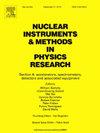The LHCb VELO detector: Design, operation and first results
IF 1.5
3区 物理与天体物理
Q3 INSTRUMENTS & INSTRUMENTATION
Nuclear Instruments & Methods in Physics Research Section A-accelerators Spectrometers Detectors and Associated Equipment
Pub Date : 2024-11-04
DOI:10.1016/j.nima.2024.170028
引用次数: 0
Abstract
The design, operation and first results from the LHCb (Large Hadron Collider Beauty) experiment Upgrade I VELO (VErtex LOcator) are presented. The Upgrade I VELO, first installed in 2022, is a crucial new detector for providing tracking during Runs III and IV of the LHC (Large Hadron Collider). The VELO, consisting of 52 modules, closes to within 5.1 mm of the beamline. Each VELO module is made up of 4 sensors with 3, 130 nm CMOS ASICs per sensor providing precise tracking (Alves et al., 2013). The modules have a novel bi-phase CO2 cooling substrate for reducing the radiation length of the detector while providing cooling under vacuum down to C. A new FPGA based SuperPixel clustering firmware reduces the data-rate by approximately 30% and is the first use of FPGA clustering in a collider experiment. During the VELO 2022–2024 commissioning period the SuperPixel performance has been validated, showing consistent rates between the packet rate and reconstructed clusters. The VELO material has been mapped confirming the safe re-installation of the RF (Radio Frequency) foil with respect to the VELO modules. Per-pixel equalisation across 41M channels has also been completed successfully reaching the design threshold of 1000 .
LHCb VELO 探测器:设计、运行和首批成果
本文介绍了大型强子对撞机(LHCb)实验升级版 I VELO(VErtex LOcator)的设计、运行和首批成果。升级版 I VELO 于 2022 年首次安装,是大型强子对撞机运行 III 和 IV 期间提供跟踪的重要新探测器。VELO 由 52 个模块组成,与光束线的距离在 5.1 毫米以内。每个 VELO 模块由 4 个传感器组成,每个传感器由 3 个 130 nm CMOS ASIC 提供精确跟踪(Alves 等人,2013 年)。模块采用新型双相二氧化碳冷却基板,可减少探测器的辐射长度,同时提供低至-30°C的真空冷却。基于 FPGA 的新型超级像素聚类固件可将数据传输速率降低约 30%,这也是 FPGA 聚类技术在对撞机实验中的首次应用。在 VELO 2022-2024 年调试期间,超级像素的性能得到了验证,显示出数据包速率和重建簇之间的一致速率。对 VELO 材料进行了测绘,确认了 RF(射频)箔片与 VELO 模块之间的安全重新安装。41M 信道的每个像素均衡也已成功完成,达到了 1000 e- 的设计阈值。
本文章由计算机程序翻译,如有差异,请以英文原文为准。
求助全文
约1分钟内获得全文
求助全文
来源期刊
CiteScore
3.20
自引率
21.40%
发文量
787
审稿时长
1 months
期刊介绍:
Section A of Nuclear Instruments and Methods in Physics Research publishes papers on design, manufacturing and performance of scientific instruments with an emphasis on large scale facilities. This includes the development of particle accelerators, ion sources, beam transport systems and target arrangements as well as the use of secondary phenomena such as synchrotron radiation and free electron lasers. It also includes all types of instrumentation for the detection and spectrometry of radiations from high energy processes and nuclear decays, as well as instrumentation for experiments at nuclear reactors. Specialized electronics for nuclear and other types of spectrometry as well as computerization of measurements and control systems in this area also find their place in the A section.
Theoretical as well as experimental papers are accepted.

 求助内容:
求助内容: 应助结果提醒方式:
应助结果提醒方式:


